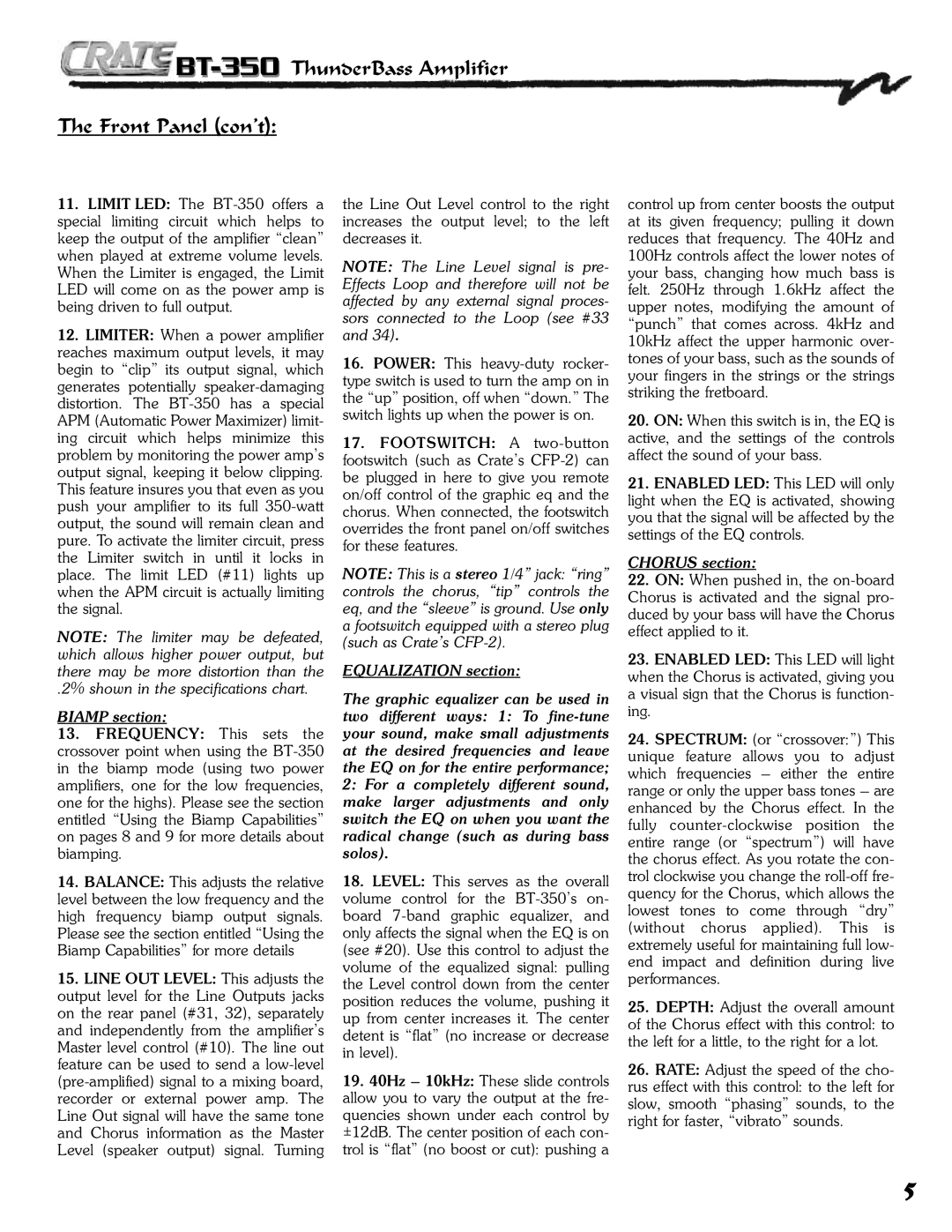
BT-350 ThunderBass Amplifier
The Front Panel (con’t):
11.LIMIT LED: The
12.LIMITER: When a power amplifier reaches maximum output levels, it may begin to “clip” its output signal, which generates potentially
NOTE: The limiter may be defeated, which allows higher power output, but there may be more distortion than the
.2% shown in the specifications chart.
BIAMP section:
13.FREQUENCY: This sets the crossover point when using the
14.BALANCE: This adjusts the relative level between the low frequency and the high frequency biamp output signals. Please see the section entitled “Using the Biamp Capabilities” for more details
15.LINE OUT LEVEL: This adjusts the output level for the Line Outputs jacks on the rear panel (#31, 32), separately and independently from the amplifier’s Master level control (#10). The line out feature can be used to send a
the Line Out Level control to the right increases the output level; to the left decreases it.
NOTE: The Line Level signal is pre- Effects Loop and therefore will not be affected by any external signal proces- sors connected to the Loop (see #33 and 34).
16.POWER: This
17.FOOTSWITCH: A
NOTE: This is a stereo 1/4” jack: “ring” controls the chorus, “tip” controls the eq, and the “sleeve” is ground. Use only a footswitch equipped with a stereo plug (such as Crate’s
EQUALIZATION section:
The graphic equalizer can be used in two different ways: 1: To
2:For a completely different sound, make larger adjustments and only switch the EQ on when you want the radical change (such as during bass solos).
18.LEVEL: This serves as the overall volume control for the
19.40Hz – 10kHz: These slide controls allow you to vary the output at the fre- quencies shown under each control by ±12dB. The center position of each con- trol is “flat” (no boost or cut): pushing a
control up from center boosts the output at its given frequency; pulling it down reduces that frequency. The 40Hz and 100Hz controls affect the lower notes of your bass, changing how much bass is felt. 250Hz through 1.6kHz affect the upper notes, modifying the amount of “punch” that comes across. 4kHz and 10kHz affect the upper harmonic over- tones of your bass, such as the sounds of your fingers in the strings or the strings striking the fretboard.
20.ON: When this switch is in, the EQ is active, and the settings of the controls affect the sound of your bass.
21.ENABLED LED: This LED will only light when the EQ is activated, showing you that the signal will be affected by the settings of the EQ controls.
CHORUS section:
22.ON: When pushed in, the
23.ENABLED LED: This LED will light when the Chorus is activated, giving you a visual sign that the Chorus is function- ing.
24.SPECTRUM: (or “crossover:”) This unique feature allows you to adjust which frequencies – either the entire range or only the upper bass tones – are enhanced by the Chorus effect. In the fully
25.DEPTH: Adjust the overall amount of the Chorus effect with this control: to the left for a little, to the right for a lot.
26.RATE: Adjust the speed of the cho- rus effect with this control: to the left for slow, smooth “phasing” sounds, to the right for faster, “vibrato” sounds.
5
